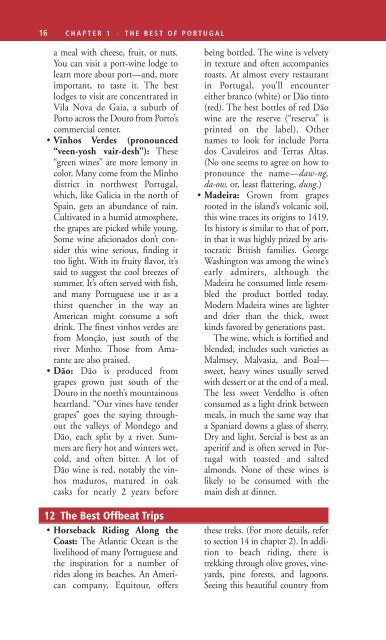Frommer's Portugal 18th Edition - Asociación de Amigos de Portugal ...
Frommer's Portugal 18th Edition - Asociación de Amigos de Portugal ...
Frommer's Portugal 18th Edition - Asociación de Amigos de Portugal ...
You also want an ePaper? Increase the reach of your titles
YUMPU automatically turns print PDFs into web optimized ePapers that Google loves.
16<br />
CHAPTER 1 . THE BEST OF PORTUGAL<br />
a meal with cheese, fruit, or nuts.<br />
You can visit a port-wine lodge to<br />
learn more about port—and, more<br />
important, to taste it. The best<br />
lodges to visit are concentrated in<br />
Vila Nova <strong>de</strong> Gaia, a suburb of<br />
Porto across the Douro from Porto’s<br />
commercial center.<br />
• Vinhos Ver<strong>de</strong>s (pronounced<br />
“veen-yosh vair-<strong>de</strong>sh”): These<br />
“green wines” are more lemony in<br />
color. Many come from the Minho<br />
district in northwest <strong>Portugal</strong>,<br />
which, like Galicia in the north of<br />
Spain, gets an abundance of rain.<br />
Cultivated in a humid atmosphere,<br />
the grapes are picked while young.<br />
Some wine aficionados don’t consi<strong>de</strong>r<br />
this wine serious, finding it<br />
too light. With its fruity flavor, it’s<br />
said to suggest the cool breezes of<br />
summer. It’s often served with fish,<br />
and many Portuguese use it as a<br />
thirst quencher in the way an<br />
American might consume a soft<br />
drink. The finest vinhos ver<strong>de</strong>s are<br />
from Monção, just south of the<br />
river Minho. Those from Amarante<br />
are also praised.<br />
• Dão: Dão is produced from<br />
grapes grown just south of the<br />
Douro in the north’s mountainous<br />
heartland. “Our vines have ten<strong>de</strong>r<br />
grapes” goes the saying throughout<br />
the valleys of Mon<strong>de</strong>go and<br />
Dão, each split by a river. Summers<br />
are fiery hot and winters wet,<br />
cold, and often bitter. A lot of<br />
Dão wine is red, notably the vinhos<br />
maduros, matured in oak<br />
casks for nearly 2 years before<br />
12 The Best Offbeat Trips<br />
• Horseback Riding Along the<br />
Coast: The Atlantic Ocean is the<br />
livelihood of many Portuguese and<br />
the inspiration for a number of<br />
ri<strong>de</strong>s along its beaches. An American<br />
company, Equitour, offers<br />
being bottled. The wine is velvety<br />
in texture and often accompanies<br />
roasts. At almost every restaurant<br />
in <strong>Portugal</strong>, you’ll encounter<br />
either branco (white) or Dão tinto<br />
(red). The best bottles of red Dão<br />
wine are the reserve (“reserva” is<br />
printed on the label). Other<br />
names to look for inclu<strong>de</strong> Porta<br />
dos Cavaleiros and Terras Altas.<br />
(No one seems to agree on how to<br />
pronounce the name—daw-ng,<br />
da-ow, or, least flattering, dung.)<br />
• Ma<strong>de</strong>ira: Grown from grapes<br />
rooted in the island’s volcanic soil,<br />
this wine traces its origins to 1419.<br />
Its history is similar to that of port,<br />
in that it was highly prized by aristocratic<br />
British families. George<br />
Washington was among the wine’s<br />
early admirers, although the<br />
Ma<strong>de</strong>ira he consumed little resembled<br />
the product bottled today.<br />
Mo<strong>de</strong>rn Ma<strong>de</strong>ira wines are lighter<br />
and drier than the thick, sweet<br />
kinds favored by generations past.<br />
The wine, which is fortified and<br />
blen<strong>de</strong>d, inclu<strong>de</strong>s such varieties as<br />
Malmsey, Malvasia, and Boal—<br />
sweet, heavy wines usually served<br />
with <strong>de</strong>ssert or at the end of a meal.<br />
The less sweet Ver<strong>de</strong>lho is often<br />
consumed as a light drink between<br />
meals, in much the same way that<br />
a Spaniard downs a glass of sherry.<br />
Dry and light, Sercial is best as an<br />
aperitif and is often served in <strong>Portugal</strong><br />
with toasted and salted<br />
almonds. None of these wines is<br />
likely to be consumed with the<br />
main dish at dinner.<br />
these treks. (For more <strong>de</strong>tails, refer<br />
to section 14 in chapter 2). In addition<br />
to beach riding, there is<br />
trekking through olive groves, vineyards,<br />
pine forests, and lagoons.<br />
Seeing this beautiful country from



